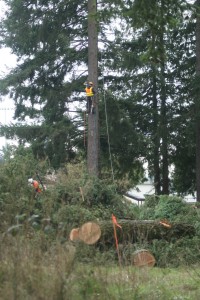Save the Trees- Seattle
Action Alert
Support a Stronger Tree Protection Ordinance for Seattle
The Seattle Department of Planning and Development (DPD) has released a draft tree ordinance that they want the Seattle City Council to pass. While it has some good points, it unfortunately weakens our current protection of trees and tree groves in Seattle and will result in further decreasing our urban forestry infrastructure that benefits all citizens by reducing storm water runoff, cleaning our air of pollutants, sequestering carbon, providing habitat for wildlife and many other benefits.
DPD’s draft proposal can be seen here:
www.seattle.gov/dpd/planning/trees
The following is a brief evaluation by Save the Trees-Seattle of the pluses and minuses of the DPD proposal. Most of the proposal deals with trees during the development process and needs to be expanded to better protect trees outside development. We need to do better to save our trees.
Some good things in the draft:
1. Adding single family homes and institutions undergoing development to the list of zones that must add street trees.
2. Requiring an online permit to remove trees larger than 24″ diameter breast height (dbh).
3. Implementing a tree removal application fee for exceptional trees to help cover cost and evaluation
4. Removing single family home lots smaller than 5000 sf from not being covered by the current ordinance.
5. Higher credit is given for evergreens saved or planted during development
What is missing from this draft:
1. Protection of tree groves
2. Protection of trees smaller than 24″ dbh, including many trees previously classified as exceptional
3. A permit system for trees smaller than 24″ dbh. Portland Oregon will cover all trees 10”dbh and larger.
4. Extending the permit system for exceptional trees to include public trees
5. Consolidating oversight, regulation and enforcement in a Department without a conflict of interest like DPD has. Trees need an advocate for their protection and Seattle Public Utilities or the Office of Sustainability and the Environment make more sense for overseeing protecting trees in the city
6. Licensing and training for arborists and tree removal companies
7. Posting completed tree removal applications on line and posting of property
8. Requiring disclosure of exceptional trees on property by real estate agents when property is sold
9. Incentives to save trees like utility rebates
10. Replacement of trees removed so there is no net loss of canopy over time, except some during development for not meeting credits
11 Requirements to id all trees on property in development plans.
12. More emphasis on native trees and habitat values in tree plantings and preservation
You can see more extensive detail on these concerns in comments delivered to the Seattle Urban Forestry Commission and posted here:
Trees in Seattle need your help and support to survive. Only about 14% of the trees in Seattle are larger than 24” dbh. This proposal would allow all trees less than 24” dbh to be cut down in Seattle!
Please send in comments in your own words expressing your concerns. Your voice needs to be heard to help protect Seattle’s trees for future generations.
Comments will be received through Oct 1, 2012. To have maximum effect, besides sending comments to DPD at
you should also forward them to the Urban Forestry Commission at
Sandra.Pinto_de_Bader@seattle.gov
and to the Seattle City Council members at
and to the Mayor at
Please bcc stevezemke@msn.com so we can track public comments being sent in.
Join us on facebook by liking our page – “Friends of Seattle’s Urban Forest”.
Financial contributions to support our campaign for a stronger tree ordinance are needed.
Make checks out to Save the Trees-Seattle and send them to:
Save the Trees-Seattle, c/o Steve Zemke, 2131 N 132nd St, Seattle, WA 98133
e-mail us at stevezemke@msn.com




